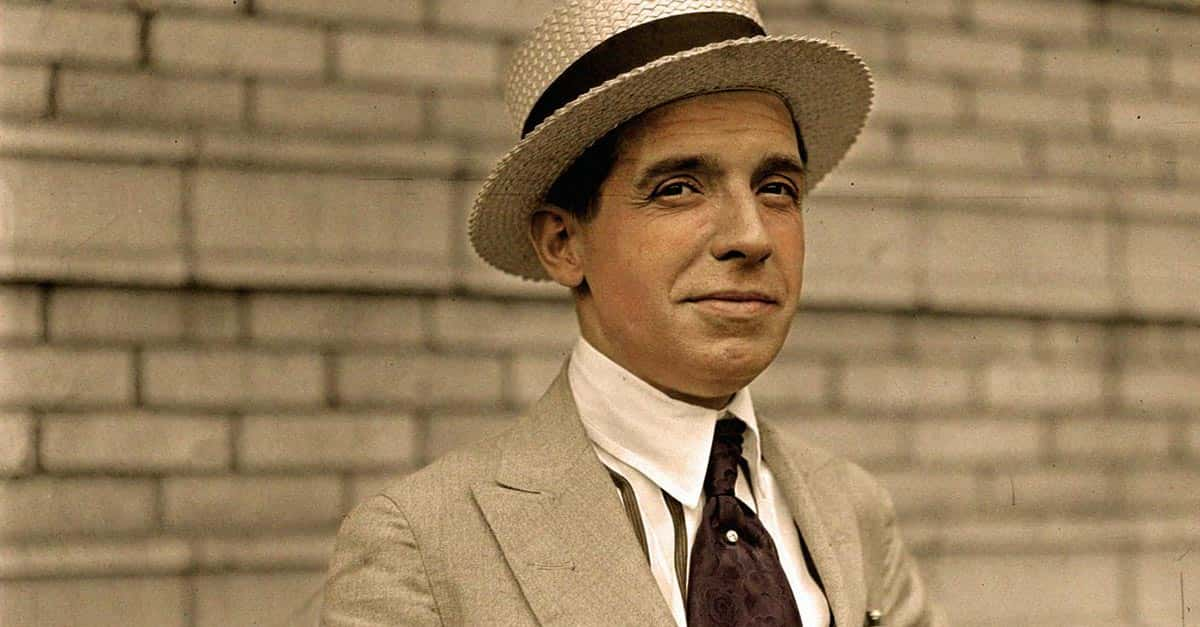10 Greatest Frauds in History
Everybody wants to get rich, well maybe excluding monks, and while the appropriate way is through hard work and patience, many have looked the other ways and devised other illicit means of acquiring wealth. These often gifted individuals do not go around with guns or knives robbing people, rather, with their words and confidence tricks, cause more damage than armed robbers. These con artists, con men, or fraudsters have the ability to trick even the most defiant people into buying into outrageous and unbelievable schemes.
Over the years there have been several popular con artists, but few have stood out either for the brilliance of their cons or the size of their schemes. Below are top 10 notable con men in history.
1. Charles Ponzi

Charles Ponzi was an Italian swindler and con artist in the U.S. and Canada. He arrived into the U.S. from Italy in 1903, and in 1919, established the Securities Exchange Co., a company which promised investors a 50% profit within 45 days or 100% profit within 90 days, by buying discounted postal reply coupons in other countries and redeeming them at face value in the United States as a form of arbitrage. The investors were however unaware that none of the funds were actually invested and that the profits came entirely from newly invested money. This birthed what came to be known as the Ponzi scheme. Ponzi was eventually charged with 86 counts of fraud in 1920 but pleaded guilty to only one. He died in 1949, but the swindle that bears his name lives on.
2. Emmanuel Nwude

Emmanuel Nwude is a Nigerian fraudster and con artist who was formerly the Director of Union Bank of Nigeria. In 1995, he defrauded a Brazilian man, Nelson Sakaguchi, who was the Director at the Brazil’s Banco Noroeste. Nwude impersonated the then Governor of the Central Bank of Nigeria, Paul Ogwuma and convinced Sakaguchi to invest in a new airport located in Nigeria’s capital, Abuja. In exchange, he asked for a $10 million commission. The fraud remained undetected until 1997 criminal investigation unearthed the scam and found out that Sakaguchi had paid $242 million in between 1995 to 1998 to Emmanuel Nwude who promised faux airport
3. Victor Lustig

Victor Lustig was a highly skilled con artist from Austria-Hungary, who undertook a criminal career that involved conducting scams across Europe and the United States during the early 20th century. His most prominent scam was a 1925 plan to sell the Eiffel Tower. Presenting himself as an official of the Ministry of Posts and Telegraphs, he told French scrap metal dealers that the Paris landmark was to be dismantled. He took bids from the dealers and selected Andre Poisson as the “winner.” When he discovered that he had won nothing, Poisson was too humiliated to even report the incident to authorities. Lustig made his way to the U.S., where he was ultimately arrested on counterfeiting charges. He pleaded guilty and was sentenced to 20 years at Alcatraz.
4. James Hogue

James Arthur Hogue is an American impostor who most famously entered Princeton University by posing as a self-taught orphan. In 1985, he stole the identity of Jay Mitchell Huntsman, who died in 1969 at just two days old. Hogue. He assumed the character of an orphan who grew up in a commune, and went to Palo Alto High School in 1986 and joined the track team. In 1987, assuming another identity with the alias Alexi Indris Santana, a self-taught orphan from Utah, and whose fictional pastimes included running barefoot in the Nevada desert. By the time he was ousted by a former Palo Alto High School, Hogue had already collected a $22,000 scholarship from Princeton.
5. Alves dos Reis

Artur Virgílio Alves Reis was a Portuguese criminal who perpetrated one of the largest frauds in history, known as the Portuguese Bank Note Crisis.In 1925, Alves dos Reis forged a government contract authorizing him to print money and “officially” printed himself 100 million escudos, the equivalent of 0.88% of Portugal’s GDP at that time. After coming out of jail over embezzlement, he developed his next scheme, posing as a representative from the central bank of Portugal and convincing a London-based company that the bank had authorized him to print his own bank notes. Reis further claimed that the money they were going to print was a part of a secret project, and it would be used to financially aid a struggling Portuguese colony, Angola. He eventually found out when the Bank of Portugal noticed the bank notes with duplicate serial numbers. Alves dos Reis was later sentenced to 20 years in jail.
6. Charles Keating

Charles H. Keating was a champion swimmer, activist, lawyer, banker, and real estate developer most recognised for is his role in the savings and loan scandal of the late 1980s. Charles Keating became the head of Lincoln Savings and Loan Association in 1984, a time when restrictions on banking investments were quite loose. Keating took advantage of this and began investing depositor’s money in high-risk investments. While his personal worth increased, his enterprises began to suffer financial problems and were investigated by federal regulators. In 1989, Lincoln Savings’ parent company, American Continental Corporation, went bankrupt. A day after, Federal authorities seized Lincoln Savings which left 23,000 customers with worthless bonds. Keating was convicted in both federal and state courts of many counts of fraud, racketeering and conspiracy in the early 1990s. He served four and a half years in prison before those convictions were overturned in 1996. In 1999, he pleaded guilty to a more limited set of wire fraud and bankruptcy fraud counts, and was sentenced to the time he had already served.
7. Gregor MacGregor

General Gregor MacGregor was a Scottish soldier, adventurer, and confidence trickster who attempted from 1821 to 1837 to draw British and French investors and settlers to “Poyais”, a fictional Central American territory that he claimed to rule as “Cazique”. MacGregor’s elaborate scheme involved printing of advertisements and leaflets and giving interviews in national newspapers. He even went on to crated and sold a guidebook which contained elaborate maps and details about this fictional country. The official-looking book convinced many people, and they started buying Poyaisian land certificates. By early 1823, about 500 people had bought Poyaisian land. When the emigrants eventually arrived at the fictitious country, realized they have been duped. Not all were able to return as most of them died due to diseases like yellow fever and malaria.
8. George C. Parker
:quality(75)/curiosity-data.s3.amazonaws.com/images/content/portrait/standard/89c2dae7-1d74-44c6-f3a4-85fdd59ed4b7.jpg)
George C. Parker was an American con man who made his living conducting illegal sales of property he did not own, often New York’s public landmarks, to unwary immigrants. He is best known for his successful attempts to “sell” the Brooklyn Bridge. Other public landmarks he incorporated into his scams included the original Madison Square Garden, the Metropolitan Museum of Art, Grant’s Tomb and the Statue of Liberty. Parker was convicted of fraud three times. After one arrest, around 1908, he escaped the courthouse by calmly walking out after donning a sheriff’s hat and coat that had been set down by a sheriff who had walked in from the cold outdoors. After his third conviction on December 17, 1928, he was sentenced to a mandatory life term at Sing Sing Prison. Parker is remembered as one of the most successful con men in the history of the United States, as well as one of history’s most talented hoaxers.
9. Marc Dreier

Marc Stuart Dreier is a former American lawyer who was sentenced to 20 years in federal prison in 2009 for committing investment fraud using a Ponzi scheme. On May 11, 2009, he pleaded guilty in the United States District Court for the Southern District of New York to eight charges of fraud, which included one count of conspiracy to commit securities fraud and wire fraud, one count of money laundering, one count of securities fraud, and five counts of wire fraud in a scheme to sell more than $950 million in fictitious promissory notes.
10. Oscar Hartzell

Oscar Merril Hartzell was an American con man who convinced many people in North America to join him in a fraudulent lawsuit against the British government. The scam began in 1915 he met a couple of con artists who promised to turn his mother’s $6000 into $6 million by giving him a share of the held fortune of Sir Francis Drake. When Hartzell realized the deal was a confidence game, he decided to use it to his own advantage. In 1919, Hartzell contacted many Iowans who had the surname Drake. He claimed that he was a distant relative and had discovered that the estate of Sir Francis Drake had never been paid to his heirs, that it had gathered interest for the last 300 years, and that it was now worth $100 billion.
Hartzell invited all these families to invest in his campaign to sue the British government for the money and assured them that everyone would make $500 for every dollar they invested. The inheritance would include the whole city of Plymouth in England. Tens of thousands of Americans sponsored him—sometimes with all the money they had. Hartzell later expanded his con to people without the surname Drake and outside of Iowa. Hartzell proceeded to move to London where he lived a luxurious lifestyle
Hartzell ws eventully caught and deported to the USA where he was sent to Iowa for trial in 1933. He was tried in Sioux City, Iowa in 1933 and was convicted of fraud in 1934, sentenced to ten years in prison and sent to Leavenworth Penitentiary
The post 10 Greatest Frauds in History appeared first on Lists.ng.
Comments
Post a Comment